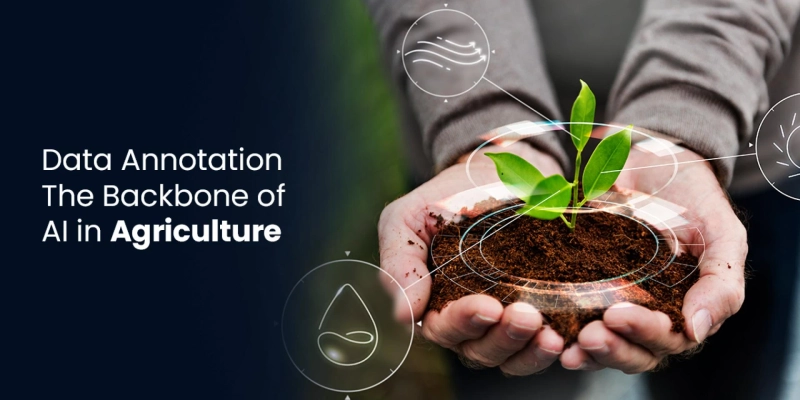Due to population growth, global food demand is expected to rise by 70% by 2050. However, climate change and limited resources make this a significant challenge. AI strengthens the agriculture industry by enabling more efficient, smarter, and sustainable farming. With precise data annotation, AI and ML can better detect crop health, manage resources, and optimize yields. Agriculture data annotation for AI helps address food security, soil monitoring, climate adaptation, and modern farming methods, making farming more resilient and productive for the future.
Key Takeaways of Agriculture Data Annotation for AI
- Accurate data annotation is crucial for training effective AI models in agriculture.
- AI is tapping new ways to improve quality, boost crop productivity, and optimize resources.
- Applications like crop health analysis, human-in-the-loop training, and precision agriculture are redefining farming.
- Agritech is adopting AI to amplify efficiency and tackle pressing issues like food security and climate change.
- More innovative AI tools empower farmers to increase crop yield by effectively controlling pests and weeds.
The Role of Data Annotation in AI Agriculture
With artificial intelligence increasingly important in agriculture, data Annotation has emerged as an integral process to create dependable machine learning models. Annotation powers AI systems to identify crops accurately and diagnose diseases by classifying and structuring raw data such as images, videos, and text. This significantly improves the precision of AI predictions and leads to data-informed decisions on the farm. With properly annotated data, AI technologies can perform crop monitoring and yield prediction, leading to greater efficiency and reduced operational costs for farmers and agri-tech firms.

The Crucial Role of Data Annotation in AI-Driven Agriculture
Data annotation is a game-changer in modern agriculture, laying the groundwork for high-performing AI systems across different farming stages.
1.Crop and Produce Monitoring
Computer vision models trained on annotated drone imagery help farmers monitor health, detect crop diseases, and precisely manage fields. Labeling crop types and health conditions in these images leads to smarter, data-backed decisions.
2.Livestock and Animal Observation
Image annotation supports AI tools that track livestock behavior and health, streamlining herd management while improving animal welfare and productivity.
3.Field Surveillance
Annotated sensor and drone data allow AI to pinpoint irrigation issues, fire risks, and pest outbreaks. This kind of intelligent surveillance reduces manual oversight and enables rapid intervention.
4.Ripeness Detection
Custom-labeled visual data trains AI to assess fruit and vegetable ripeness accurately. This ensures optimal harvest timing and minimizes waste.
5.Weather Forecasting and Prediction
Labeled environmental and satellite imagery trains AI to forecast weather patterns. This empowers farmers with early warnings and better crop planning.
6.Sorting and Quality Control
Agentic AI, driven by annotated visual data, independently sorts products to proceed only with high-quality ones. This boosts quality control and reduces post-harvest or production losses.
7.Crop Yield Forecasting
AI models can accurately predict yield by leveraging annotated text and image data. This supports inventory management, innovative logistics, and policy planning.
Challenges of Agriculture Data Annotation for AI
Data annotation for Agriculture AI is challenging due to the need for deep domain expertise, the diversity of crops and diseases, and the time-sensitive nature of farming cycles. Inconsistent labeling standards and large-scale data volumes also make quality control and scalability difficult.
1.Requirement of Domain Knowledge
Farm data annotation is not simply annotating images or sensor readings; it requires plant biology, soil science, and entomology expertise. For example, correctly identifying various crop diseases, pest insects, or growth phases involves skilled agronomists or seasoned field staff. If such knowledge is lacking, annotations will be wrong, which means AI models cannot be trusted.
2.Variability and Heterogeneity of Data
Agriculture encompasses a wide variety of crops, with each having distinct visual features, growth patterns, and environmental dependencies. Visual signs of various plant diseases tend to overlap, and agricultural practices differ significantly by region. Data annotation in such a heterogeneous ecosystem requires customized approaches, complicating standardization and multiplying annotation complexity.
3.Time Sensitivity and Seasonal Cycles
Crops have natural growth cycles, so annotation projects have to fit within these timeframes. Skipping a crucial growth phase, such as flowering or fruiting, can taint the quality of training data. Certain crops, such as strawberries or tomatoes, have very short harvesting windows, so data collection and annotation should be followed efficiently in real time.
4.Scalability and Resource Demands
Agriculture creates enormous datasets, from drone videos and time-series sensor measurements to satellite imaging and farm photography. Manually annotating such a quantity in batch processing mode and involving coordinated groups within time limitations is time-consuming. This becomes increasingly difficult for remote or expansive farms, where gathering the data alone would be logistically challenging.
5.Lack of Standards and Quality Control
There usually isn't a standard way of labeling agricultural features. For instance, measuring the severity of disease ("mild" versus "moderate") is not objective and differs among annotators. Likewise, regional customs could define soil quality or irrigation levels differently. Lacking baseline benchmarks or reference datasets, annotation consistency is a significant challenge.
Solutions to Agriculture Data Annotation Challenges for AI
1.Engaging Agronomy Experts in the Loop
To solve the domain expertise problem, annotation projects can employ a human-in-the-loop approach by incorporating expert agronomists, plant pathologists, or seasoned farmers. Such experts can analyze and confirm difficult labels to guarantee accuracy and validity.
2.Creating Custom Annotation Protocols
Due to crop and region heterogeneity, the development of crop-specific annotation templates and region-specific labeling guidelines assists in standardizing without losing flexibility. Utilizing modular labeling schemes customized to plant varieties or regional methodologies augments consistency.
3.Distributed Annotation Platforms
Scalable annotation platforms permit managing large remote groups, making batch processing of large datasets, such as satellite images, drone, or IoT sensor data, possible. They guarantee speed at the expense of nothing but speed.
4.Building Benchmark Datasets and Ontologies
Having standardized benchmarks and standard agricultural ontologies can decrease labeling uncertainty. Common reference images for disease severity or growth stages ensure that is the same for every annotator.
5.Ongoing Quality Monitoring and Feedback Loops
Quality control can be enhanced by including inter-annotator agreement measures, active learning loops, and feedback processes. Random sampling checks and AI-flagged uncertainty scores also assist in catching and fixing inconsistencies early.
Conclusion
Data annotation is the behind-the-scenes hero driving AI innovation in agriculture. It turns raw agricultural data into actionable insights by facilitating accurate crop monitoring, disease identification, and yield prediction. Overcoming annotation challenges through expert participation, customized protocols, and sophisticated tools guarantees that AI models are reliable and scalable. Data annotation is the key to creating a brighter, more sustainable future for global agriculture.


